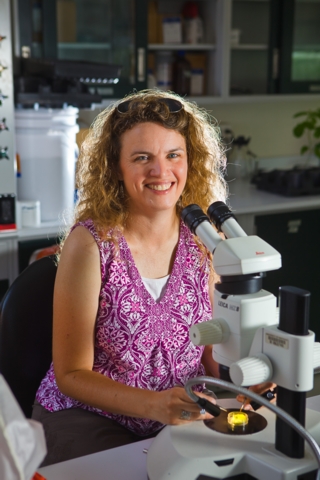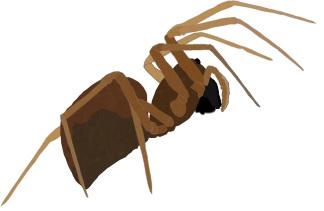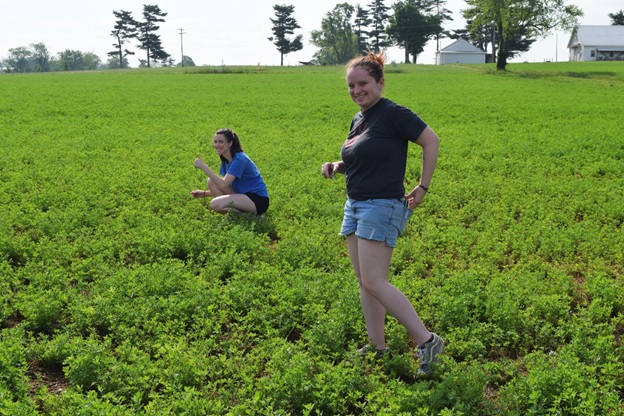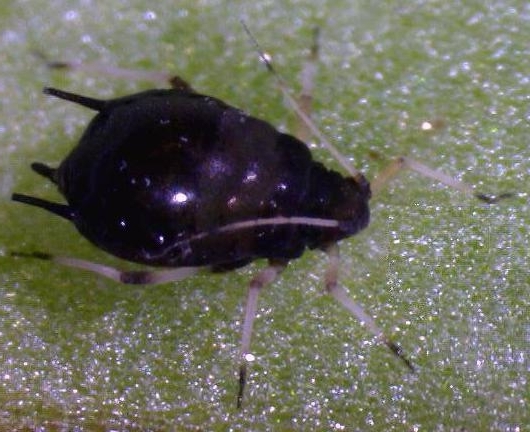Jen White

Last Revised: Dec 4th, 2023
Professional Biography
Research Interests
The focus of my laboratory is investigating the ecological, evolutionary, and behavioral effects of bacterial endosymbionts in arthropods. In particular, we are interested in exploring the consequences of endosymbiont infection within the context of introduced species and biological control.
Maternally-inherited bacterial endosymbionts are common among arthropods. Some symbionts are obligate and mutualistic, providing their hosts with nutrients or performing other essential functions in their hosts. Other symbionts are “facultative”, without which hosts can survive and potentially thrive. In recent years, it has become increasingly evident that these facultative symbionts can have major effects on their host’s biology, including: manipulation of host reproduction, influencing dispersal, affecting host plant choice, changing host temperature tolerances, altering fecundity, and providing defense against parasitoids, fungi, and viruses. These effects, in turn, have the potential to influence the ecological interactions between infected hosts and other members of the community. For example, an aphid that is infected by a symbiont that protects against parasitism may be harder to control biologically, and more likely to reach pest outbreak status, than an uninfected aphid. Yet studies that address these ecological effects of bacterial symbionts in the field are rare. The ultimate goal of my research program is to test the importance of bacterial symbionts in driving pest/enemy interactions in the field.

Currently, lab research is centered on spiders, particularly a tiny sheetweb spider, Mermessus fradeorum. This spider, which is found in disturbed agricultural settings, can be simultaneously infected by up to five separate strains of inherited bacterial symbiont that manipulate the spider's reproduction in various ways. Our focus is understanding the collaborative versus competitive ways these symbionts interact in their shared host, and how these interactions affect symbiont spread in the host spider population.
Current and recent lab members include:
- Laura Rosenwald: Laboratory Technician
- Dr. Emily Durkin: now an Assistant Professor at the University of Tampa.
- Jordyn Proctor: NSF REPS fellow
- Hannah Brown, NSF REU summer extension intern
- Zayla Granillo, NSF REU summer intern
- Joshua Griffith, NSF REU summer intern
- Kaitlin Butler, undergraduate lab assistant
- Erica Knorpp, undergraduate lab assistant
- Ellen Williams, undergraduate lab assistant

Aphis craccivora (photo by Cristina Brady)
Other Lab Alumni
- Dr. Justin Kratovil, former postdoc, is a postdoc at UConn
- Thor Hansen, MS 2018, is a PhD student at Purdue
- Kelly Jackson, MS 2016, is an extension agent in New York
- Dr. Paul Lenhart, former postdoc, is a Captain in US Army
- Alex Styer, former technician, is an NSF Fellow at UC Berkeley.
- Allison Dehnel, former technician, is now located in Gainesville, FL. If you are in the area, you should hire her. She's fantastic.
- Yong-Ming Ruan, visiting scholar, is back at his home institution, Zhejiang Normal University, Jinhua, China.
- Dr. Jason Wulff, PhD 2014, is employed at MRIGlobal.
- Josh McCord, BS 2014, works at Southwest Ohio Air Quality Agency.
- Abi Saeed, MS 2014, is an extension agent in Montana
- Meghan Curry, MS 2014, is working for a non-profit in El Paso
- Steve Wagner, defended his MS in 2014, and works for Syngenta.
- Cristina Brady, MS 2012, is a Research Specialist in the Department of Cell & Developmental Biology at the University of Pennsylvania.
- Ali Maldonado, former technician, relocated to Trimble Co., KY, where she teaches junior high.
- Dr. Cheryl Lindsay Bowker, former technician, is the Associate director of the STEM center at Colorado State University.
- Dr. Susan Romero, former technician, worked for the USDA in Arizona, identifying insects intercepted at the border.
Information for Prospective Students
We are recruiting a graduate student to model host/symbiont population dynamics and evolution in our spider system. We are particularly interested in applicants whose interests bridge theory and empirical studies. Please contact me at jenawhite@uky.edu if you are interested in learning more.
Select Publications
- Rosenwald, L.C., M.I. Sitvarin, J.A. White. 2020 Endosymbiotic Rickettsiella causes cytoplasmic incompatibility in a spider host. Proceedings of the Royal Society B 287: 1107. https://doi.org/10.1098/rspb.2020.1107
- White, J.A., A. Styer, LC Rosenwald, MM Curry, KD Welch, KJ Athey, EG Chapman. 2020. Endosymbiotic bacteria are prevalent and diverse in agricultural spiders. Microbial Ecology 79: 472-481. https://doi.org/10.1007/s00248-019-01411-w
- Lenhart, P.A., K. A. Jackson, J.A. White. 2018. Intraspecific variation in prey defence provides refuge for subdominant predators. Proceedings of the Royal Society B, Biological Sciences 285: 20180523. https://doi.org/10.1098/rspb.2018.0523
- Desneux, N., M.K. Asplen, C.M. Brady, G. E. Heimpel, K. R. Hopper, C. Luo, L. Monticelli, K. M. Oliver, J. A. White. 2017. Intraspecific variation in facultative symbiont infection among native and exotic pest populations: potential implications for biological control. Biological Control 116: 29-35. DOI: 10.1016/j.biocontrol.2017.06.007
- Jackson, K.A., J.S. McCord, J.A. White. 2017. A window of opportunity: subdominant predators can use suboptimal prey. Ecology and Evolution 14: 5269-5275.
- White, J. A., J.S. McCord, K.A. Jackson, A.K. Dehnel, P.A. Lenhart. 2017. Differential aphid toxicity to ladybeetles is not a function of host plant or facultative bacterial symbionts. Functional Ecology 31:334-339. DOI: 10.1111/1365-2435.12736
- Wagner, S.M., A. J. Martinez, Y. Ruan, K. L. Kim, P. A. Lenhart, A. C. Dehnel, K. M. Oliver, and J. A. White. 2015. Facultative endosymbionts mediate dietary breadth in a polyphagous herbivore. Online early, Functional Ecology 29: 1402-1410. DOI: 10.1111/1365-2435.12459
- Saeed, A., J. A. White. 2015. Surveys for maternally-inherited endosymbionts reveal novel and variable infections within solitary bee species. Journal of Invertebrate Pathology 132: 111-114. DOI: 10.1016/j.jip.2015.09.011
- Curry, M.M., L. V. Paliulis, K. D. Welch, J. D. Harwood, J. A. White. 2015. Multiple endosymbiont infections and interacting reproductive manipulations in a linyphiid spider population. Heredity 115: 146-152. DOI: 10.1038/hdy.2015.2
- Wulff, J. A., and J. A. White. 2015. The endosymbiont Arsenophonus provides a general benefit to soybean aphid (Hemiptera: Aphididae) regardless of host plant resistance (Rag). Environmental Entomology 44: 574-581. DOI: 10.1093/ee/nvv03
- Brady, C.M., M. Asplen, G.E. Heimpel, K.R. Hopper, C. Linnen, K.M. Oliver, J.A. Wulff, and J.A. White. 2014. Worldwide populations of Aphis craccivorahave diverse facultative bacterial symbionts. Microbial Ecology 67: 195-204. DOI: 10.1007/s00248-013-0314-0
- Brady, C.M., and J.A. White. 2013. Cowpea aphid (Aphis craccivora) associated with different host plants has different facultative endosymbionts. Ecological Entomology 38:433-437DOI: 10.1111/een.12020
- Wulff, J.A., K.A. Buckman, K. Wu, G.E. Heimpel, and J.A. White. 2013. The endosymbiont Arsenophonus is widespread in soybean aphid, Aphis glycines, but doesn't provide protection from parasitoids or a fungal pathogen PLOS ONE 8:e62145.
- White, J.A., M. Giorgini, M. Strand, F. Pennacchio 2013. Arthropod endosymbiosis and evolution. Pp. 441-477 in Arthropod Biology and Evolution – Molecules, Development, Morphology. A. Minelli, G. Boxshall and G. Fusco, eds. DOI: 10.1007/978-3-642-36160
- Brady, C.M., and J.A. White. 2012. Late instar parasitism of whitefly hosts by Encarsia inaron has negative consequences for both parasitoid and host. Annals of the Entomological Society of America 105:840-845.
- White, J.A. 2011. Caught in the act: rapid, symbiont-driven evolution. BioEssays 33: 823-829.
- White, J.A., S. E. Kelly, S. N. Cockburn, S. J. Perlman, M. S. Hunter. 2011. Costs and benefits of endosymbiont infection in a doubly-infected parasitoid. Heredity 106: 585-591.
- White, J.A., S. Kelly, S. Perlman, M. S. Hunter. 2009. Cytoplasmic incompatibility in the parasitic wasp Encarsia inaron: disentangling the roles of Cardiniumand Wolbachia symbionts. Heredity 102: 483-489.
- White, J. A., and D. A. Andow. 2006. Habitat modification contributes to associational resistance between herbivores. Oecologia 148: 482-490.
- White, J. A. and T. G. Whitham. 2000. Associational susceptibility of cottonwood to a box elder herbivore. Ecology 81: 1795-1803.

